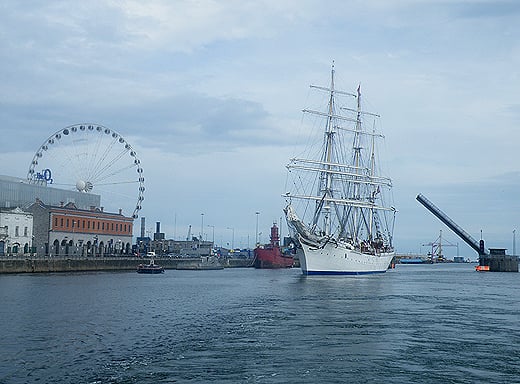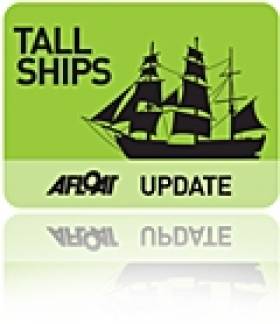Displaying items by tag: Waterford Tall Ships Races 2011
Container Ship Successfully Refloated in Waterford Harbour
In attendance was Bargarth, a UK-flagged tug based in Waterford and operated by Fastnet Shipping. The twin Voith & fire-fighting tug made a special appearance during the Tall Ships Races Parade of Sail on 3 July, when she put on a celebratory water-display off Dunmore East.
Samskip Eandeavour is capable of handling 812 twenty-foot equivalent containers (TEU). She was completed only this year by Damen Gorinchem Scheepswerf B.V. Foxtol in the Netherlands. The vessel is operated by an Icelandic company, Samskip which provides several container feeder-liner services between Rotterdam / Zeebrugge with Belfast, Dublin, Cork and Waterford.
After unloading and loading at Belview the 140m vessel is scheduled to dock in the Port of Cork tomorrow at the Tivoli Container Terminal before returning to Europe.
Norwegian Tallship Opens to the Public in Dublin Docklands
The arrival of the largest and oldest Norwegian tallship the barque S/S Statsraad Lehmkuhl into Dublin Port yesterday made for an impressive sight, even without her sails set, writes Jehan Ashmore.



Her arrival marks nearly a year in advance to Dublin City welcoming the return of the Tall Ships Races, presented by Szczecin and organised by Sail Training International. The capital last hosted the event in 1998 and next year up to 100 tall ships are to sail into the capital which will be the final host port for four days between 23rd-26th August 2012.

Tall Ship S/S Statsraad Lehmkuh in Dublin Bay yesterday. Images: Iain White
The celebration of sail is expected to draw entrants from as far away as Chile, Mexico, Argentina, USA and European and Baltic countries including Italy and Norway will chart their course to Dublin. It is hoped that the event will attract over a million visitors to the city, topping the 500,000 spectators who thronged the Waterford quays during this year's tall ship race gathering.

Photo: Jehan Ashmore
Waterford Tall Ships Races 2011 Participant Sails into Dublin
The Jubilee Sailing Trust's (JST) three-masted 'flagship' STS Lord Nelson arrived into Dublin today (Wednesday) as part of her sail-training programme. The barque is one of over 30 tall ships so far confirmed out of an expected 70 entrants for next year's Tall Ships Races starting from Waterford, writes Jehan Ashmore.
In the 'A' class tall ships (the large square-rigged vessels) the Lord Nelson will be sharing this category with a further six ships representing these impresssive vessels to include Christian Radich, Europa and the Polish Pogoria, which also called to Dublin recently.
The Lord Nelson will participate in the first race between Waterford and Greenock. From the Scottish port the tall ships will 'Cruise-In-Company' to Lerwick, the capital of the Shetland Islands. The race then crosses the North Sea to Stavanger, Norway and the final leg is to culminate in the Swedish west coast port of Halmstad in early August.
The Lord Nelson was designed by Colin Mudie and is specifically constructed to enable people of all physical abilities to sail side-by-side as equals. The vessel has an overall length of 54.7m and when under canvas (1,024m2) that's all 18 sails, Lord Nelson can achieve around 10 knots.
In addition to Lord Nelson, the JST which is run as a registered charity operates the SV Tenacious. Likewise this barque is designed for the same purpose and they can claim to be the only tall ships in the world having this distinction of providing sailing opportunities for all.
Since the charity started in 1978, over 36,000 people have sailed with the trust. Of those, over 24,000 people have sailed onboard Lord Nelson, which was launched in 1986, and 12,000 have sailed on Tenacious which was launched in 2000.
The countdown for the Waterford Tall Ships Races 2011 continues with less than 281 days to go!...The prestigious event is organised by Sail Training International in association with Szczecin.
Looking for further reading on Tall Ships in Ireland? Click the links below:
Click this link to read all our Tall Ships Stories on one handy page
Previewing Ireland's Tall Ships 2011 Season
Can Ireland Get a New Tall Ship?


























































